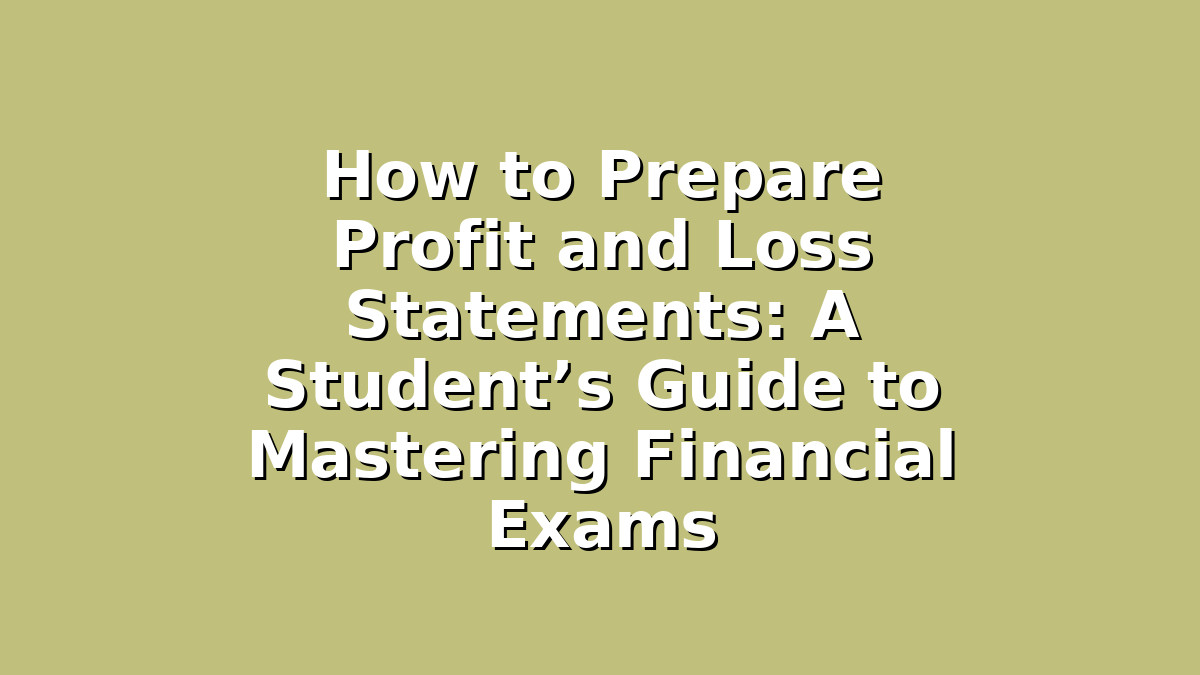If you’re a student preparing for exams in accounting, finance, or business studies, understanding how to prepare a Profit and Loss (P&L) statement is essential. Not only is it a fundamental skill tested in exams, but it also forms the basis for many real-world business decisions. The good news? With the right approach and study techniques, you can master this topic and boost your confidence for exam day.
In this guide, we’ll break down effective strategies for studying and preparing Profit and Loss statements, helping you grasp the concepts, organize your work, and excel in your tests.
Understanding the Basics Before You Begin
Before diving into how to prepare a Profit and Loss statement, make sure you understand what it is and why it matters. A P&L statement, also known as an income statement, summarizes a company’s revenues, costs, and expenses over a specific period. The end goal is to calculate the net profit or loss, which shows whether the business made money or faced a deficit.
As a student, the first step is to get comfortable with the key components of the P&L statement:
– Revenue/Sales: Total income earned from goods or services.
– Cost of Goods Sold (COGS): Direct costs tied to producing goods or services sold.
– Gross Profit: Revenue minus COGS.
– Operating Expenses: Indirect costs such as rent, salaries, utilities.
– Net Profit or Loss: Gross profit minus operating expenses.
Having a strong grasp of these elements sets the foundation for preparing accurate statements and answering related exam questions.
—
Section 1: Break Down the Process Step-by-Step
One of the best ways to tackle P&L statements is by breaking the preparation into manageable steps. This method will not only simplify your learning but also help you avoid mistakes during exams.
1. Gather Your Data: Start by listing all the relevant financial information you have been provided — sales figures, expenses, and any additional income.
2. Calculate Revenue: Sum up all sales or income sources. Be sure to distinguish between cash and credit sales if required.
3. Determine COGS: Identify the direct costs involved in producing the goods or delivering services. This might include raw materials, direct labor, and manufacturing overheads.
4. Compute Gross Profit: Subtract COGS from total revenue.
5. List Operating Expenses: Include all indirect expenses such as administrative costs, marketing, rent, and utilities.
6. Find Net Profit or Loss: Subtract total operating expenses from gross profit.
7. Double-Check Your Work: Review calculations, ensure all data is included, and verify your final net profit or loss.
By practicing this systematic approach regularly, you’ll develop a routine that will help you handle even complex statements with ease.
—
Section 2: Use Visual Aids and Practice Questions to Reinforce Learning
Visual aids such as charts, diagrams, and example templates can help you better understand the flow and layout of Profit and Loss statements. Try creating your own P&L templates where you can fill in data during practice sessions. This active engagement makes the learning process more interactive and cements your understanding.
Additionally, solving practice questions is one of the most effective ways to prepare. Look for past exam papers, worksheets, or online quizzes related to Profit and Loss statements. When working through these problems:
– Time yourself to simulate exam conditions.
– Check your answers against solutions or mark schemes.
– Analyze any errors to understand where you went wrong.
You can also form study groups where you quiz each other or explain concepts aloud. Teaching others is a powerful way to deepen your own knowledge.
—
Section 3: Connect Theory with Real-Life Examples to Stay Motivated
Sometimes studying accounting concepts can feel abstract or dull. To keep your motivation high, try connecting the theory of Profit and Loss statements with real-world businesses or scenarios you find interesting.
For example, think about your favorite café or a local store. Imagine how their sales are recorded, what costs they incur, and how they figure out their profits. You might even look up financial reports of publicly traded companies online to see actual P&L statements.
Understanding the practical application not only makes the subject more engaging but also helps you appreciate why accuracy and attention to detail are crucial when preparing these statements.
—
Conclusion
Preparing Profit and Loss statements can seem challenging at first, but with a clear understanding of the components, a step-by-step approach, and consistent practice, you’ll gain confidence and excel in your exams. Use visual aids and practice questions to reinforce your learning, and try to relate the material to real-life contexts to stay motivated.
Remember, every expert was once a beginner. Keep a positive mindset, practice regularly, and soon you’ll find Profit and Loss statements becoming second nature.
Good luck with your studies!

Responses